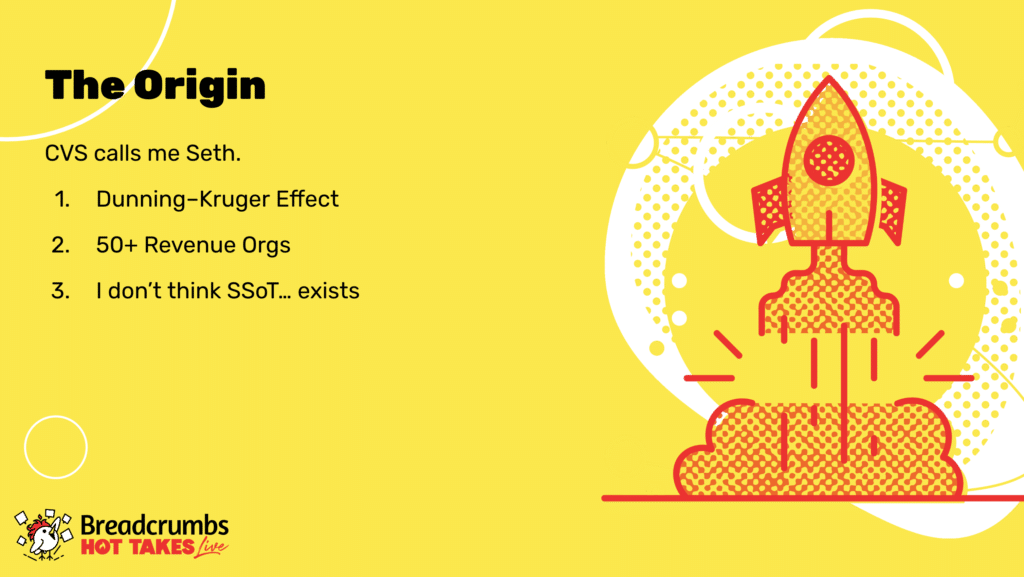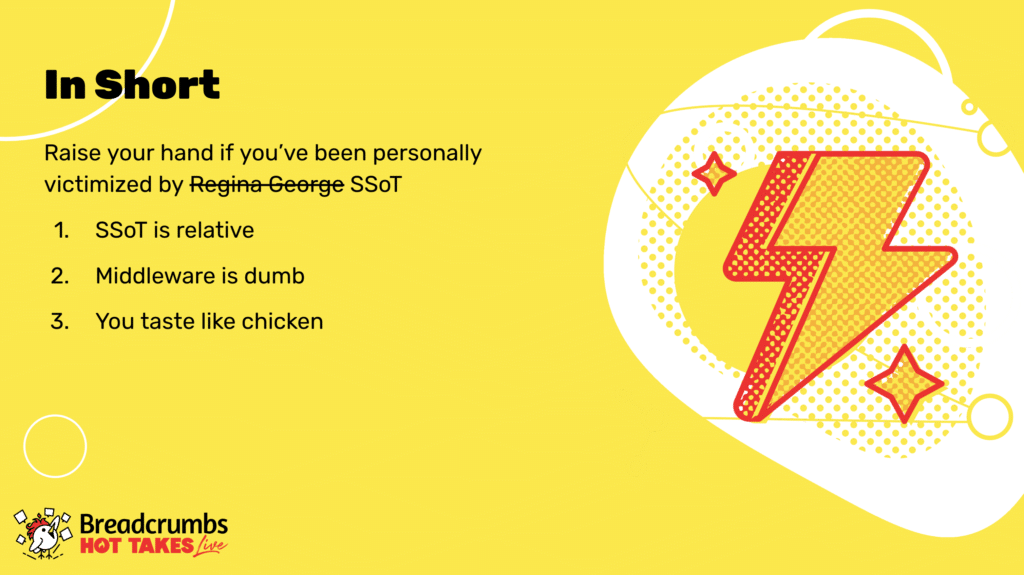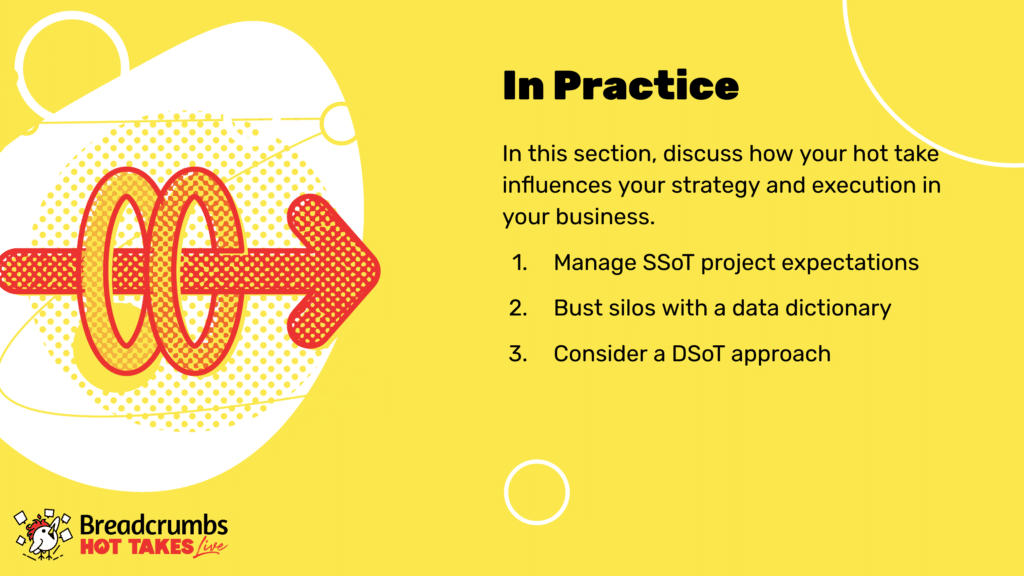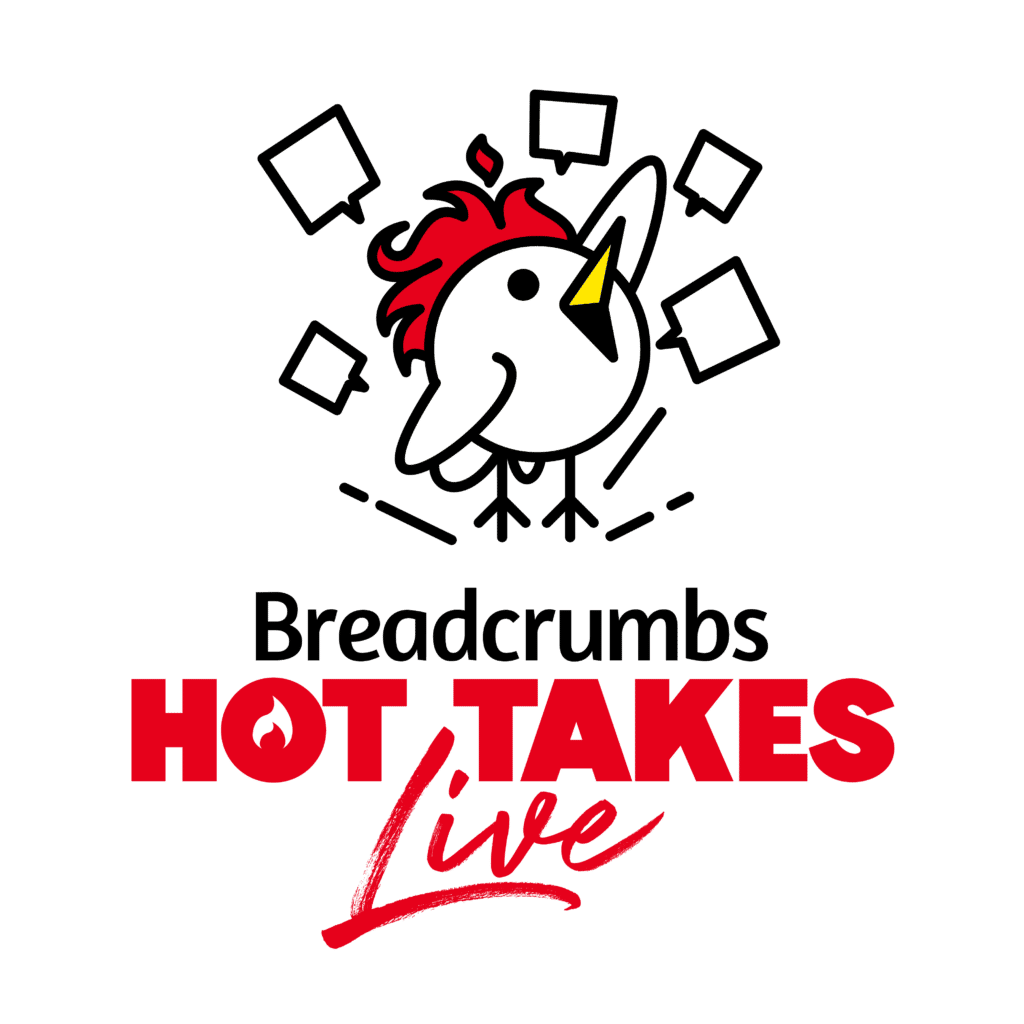“Single Source of Truth” has been the rallying cry of RevOps for years–it’s a futile, arrogant exercise that will hobble your progress.
Distributed Source of Truth is the way of the future.
In this session with Jacki Leahy, founder and fractional RevOps Advisor at Activate the Magic, you will learn:
- The difference between a Single Source of Truth and a Distributed Source of Truth
- Limitations of a Single Source of Truth
- Three advantages of a Distributed Source of Truth
[Transcript] Enough With The Single Source of Truth Nonsense
Although transcriptions are generally very accurate, just a friendly reminder that they could sometimes be incomplete or contain errors due to unclear audio or transcription inaccuracies.
Joe Aicher
Back from that quick coffee break, and lunch break–it was both for me, so hopefully, you all got refueled and are ready for another few presentations. I’m gonna bring on Jackie, who is joining us with another interesting topic, so Jackie, welcome, thanks for joining.
Jacki Leahy
Thank you. Good to be here.
Joe Aicher
Yeah, I will pull up your presentation and step out of the way. Good luck and I will join back up with you in about 10 minutes or so.
Jacki Leahy
Okay, cool. Hello, Hot Takes Live audience! I’m Jackie Leahy, and I am going to be talking about how Single Source of Truth is nonsense, and I’ve had enough of it.
So, I am the founder of Activate the Magic; we are a fractional RevOps advisory and an interesting fact about me–I was the mascot in college. It was U-Mass Amherst, so technically I was a D1 athlete, technically but not really.
Okay, so here’s the origin of how I think Single Source of Truth is a bunch of nonsense.
I can explain this by the Dunning-Kruger effect; that is how the less I know about something, the more of an expert I feel like I am on it, and the more and more that I learn, the more and more I realize that I actually know nothing, I know nothing.
I think that is super applicable to the Single Source of Truth situation where CEOs and CROs, and the LinkedIn sphere, talk about how you gotta have a Single Source of Truth. You gotta, you gotta, you gotta, and if you’re not, if you don’t have one, then you don’t know what you’re doing, or you can’t do it.
I couldn’t figure out how to do that, and as a Salesforce consultant, and RevOps consultant, I’ve seen more than 50 Salesforce orgs in Revenue org, like deeply, intimately, and I’ve not seen one in the wild. I really haven’t, I would really like to see one.

You know CVS? Like, Extra Care, like they literally have all of my prescriptions, they know what hair products I use, they know everything, and yet they think my first name is Seth. I have no idea when Seth went in as my first name, but they’ve got my phone number, they’ve got my email, they’ve got my medical history… but they call me Seth.
I’ve actually tried to correct this. This has been, I think, more than 10 or 11 years since the Extra Care card came out, and I’ve talked to store managers, I’ve called. No, cannot get figured out.
So, I’m beginning to think that ‘Single Source of Truth’ actually doesn’t exist, and yet–and yet, I feel bullied by the Single Source of Truth. So I liked the Mean Girls reference, “Raise your hand if you’ve been personally victimized by Regina George”, and in this case, it’s Single Source of Truth.

So, the more I learn about data and how it works and data links and all the data connectors, if Single Source of Truth does exist, it’s extremely contextual. It is extremely relative, so maybe there’s a Single Source of Truth for the sales team, and there’s a Single Source of Truth for the marketing team, and there’s a Single Source of Truth for the finance team; but there is not one major Single Source of Truth for the entire work.
The middleware as we know it up until now has been extremely dumb and extremely frustrating because it is not future-proof. You change one thing, and you mess up everything else, so especially like the endpoint to endpoint like Zapier, one thing gets updated, and you’re broken, and if all your other zaps or all your other middleware rely on that, then you’ve got a popsicle stick train that’s just totally broken. It’s dumb.
My third point is, I got “you taste like chicken,” and I think Ops people know this where your architecture, your data is not special. It might be a little bit unique based on what it is you sell and how you sell it, but in B2B SaaS Tech, we really all taste like chicken.
We’ve got leads, we’ve got opportunities, we’ve got customers, we’ve got product and so it feels like all of these software solutions are trying to sell to us by saying you’re special and you need this, you’re special, you need this. No, we’re not special; we’re actually all pretty much the same.
So now that I’ve come to this very depressing realization that I’ve been bullied for eight years, here’s how I’m managing this realization in real life.

So if there is a Single Source of Truth project that you’re being brought in on, either if it’s a client or for your internal team, you really want to manage those project expectations. Like, exactly what is the scope of this and really push back on any sort of highfalutin idea that you’re going to have a Single Source of Truth for the entire organization. So, pay your dues upfront so you’re not paying the tax later and really manage those project expectations.
One way to break those silos and have at least a Rosetta Stone of what everyone’s talking about is by having a data dictionary. You can go to the Open SaaS Institute, which is like a Wiki for SaaS metrics, and really get on the same page across your organization. For instance, when we say “customer,” what do we actually mean? When we say “lead,” what actually do we mean?
Aside from how Salesforce defines something, or how your PostgreSQL situation describes something, or Zendesk, or Marketo, outside of those very specific definitions, what are your organization’s definitions?
Considering a distributed source of truth approach can be helpful. Companies like Syncari and GetCargo are realizing that a data lake is inappropriate for everything, and something going in and not being able to find it isn’t appropriate. But having a central place where you can orchestrate, normalize, and keep data in-sync across the organization is super useful.
Not having, not being like, “Well, everything has to be in Salesforce.” No, it can be in all the places, but let’s get on the same page about what is the winning source of truth for different objects and fields in terms of your entire org’s data organization.
So, my key takeaway is, if you’re a RevOps person like me, try not to get bullied by what everybody is saying about what you’re supposed to do. Bring a little levity and have some self-confidence that, actually, the world is ambiguous, and you’ve got this.
I host a RevOps Witchcraft office hours; it’s the third Tuesday of every month. You can hop on in and hear what other people are talking about, or if you’ve got no idea what you’re doing or you’re looking at CPQ vendors and want to hear what’s going on, you can join in. It’s just a jam session about Rev-Ops.
It’s magical.wiki/officehours.

Hot Takes Live
Replays
Catch the replay of Hot Takes Live, where 30 of the top SaaS leaders across Marketing, Sales, and RevOps revealed some of their most unpopular opinions about their niche.
These leaders shared what lessons they learned and how they disrupted their industry by going against the grain (and achieved better results in the process).
Joe Aicher
Yeah, thanks, Jackie. That was awesome. I appreciate you walking through all of that. Look, this is something that, from an operations point of view, I think we’ve been lying to ourselves for a long time, thinking that there’s got to be that single source of truth, and we’re constantly on a mission to build it because it doesn’t exist.
It’s like a long, long tail project, but I think some of the easy things that you outlined are, or one of the easier things you outlined to get started, is this idea of like a data document, right?
So, what are some of the things, some of the strategies that you’ve put in place early on with companies that are starting down this path to get everybody on the same page about what certain things mean in different places, in different systems? How does that data document start to grow and build within an organization?
Jacki Leahy
I would recommend having a data dictionary squad, a cross-functional team that is committed to having a data dictionary. Don’t assume everybody is in agreement on things like churn or NRR; there are actually multiple ways you can calculate those. So bring that beginner’s mind, set aside blame or shame or self-beat up, and really just bring your curiosity and humility.
You get on the same page of what those metrics, what those words mean, what those definitions mean, and how we calculate those.
Yeah, and having a squad that’s across the org that’s really committed to getting on the same page about what our data is and what it means.
Joe Aicher
Yeah, I think having like those cross-functional leaders know their chunk of the business better than anybody right in an organization, and they’ve probably, if you’ve let it go on too long, the definitions start to get all out of whack, and they have their own way of talking about the business.
We just had a presentation with Kathleen talking about that communication between marketing and finance that’s like worlds away, right? It seems like when we’re talking about operations, but being able to talk about those things on the same terms is a huge way to get your teams aligned. I’m curious too on the technology.
So, do you have a preference? I think I asked this maybe in an earlier session around if you did have a preference for that main source of truth, right? The distributed source of truth that you mentioned, is there still a more reliable place to focus your attention on as you start?
Like, I know there are new technologies and new tools being added and different metrics coming out of everywhere, but is there, is it the CRM, is it the MAP, is it a data warehouse or something like that? Where do you generally focus your attention on and build off of there?
Jacki Leahy
Yeah, it totally depends on the stage of the company. It could totally be HubSpot or Salesforce if you’ve got like 100 employees, you know. But once you really start adding in like ERP and product and generating like product insights for sales and all that, that’s the point that I really recommend that you have like a middleware 2.0 solution that’s normalizing and orchestrating data across the org.
My go-to right now is Syncari. And instead of being bullied by how Salesforce thinks about data or how Zendesk or how Marketo thinks about data architecture and what makes the most sense, you can build your own data architecture that makes more sense for your entire company.
Joe Aicher
Definitely, yeah. I mean, how many times have we opened up a HubSpot instance without life cycle stages aligned with what’s already existing in a Salesforce instance, right? And how do you have those things on the same page?
And yeah, having that middleware is massive in order to make that happen.
Jacki Leahy
Yeah, and a lot of times, it really isn’t the tech that’s blocking us; it’s our definitions and our alignment. Like, what are our life cycle stages, and does the product agree? Or does Finance agree?
The more we come to the table together to figure it out in the beginning or even if you’re like, “Actually, this is a mess, let’s look at this,” otherwise, what tends to happen, what I normally see happen, is like fiefdoms of data, right?
Like, “Well, we’re sending over all these leads,” and marketing is like, “We’ve crushed our metrics,” and sales is like, “What are you talking about? You only sent over two of how we think a lead is.”
And so, in that sort of fiefdom fighting, whoever has the CEO’s ear last wins, right? It’s just…it’s everywhere, and it sucks.
Joe Aicher
Yeah, well, Jackie, we’re up against time. I want to thank you for joining us today. For anybody that wants to catch this afterwards, we’ll have recordings. Obviously, check out Jackie’s offer, and feel free to check out her site.
Once again, thank you, best of luck going forward, and yeah, great presentation.
Jacki Leahy
Thanks, Joe.
